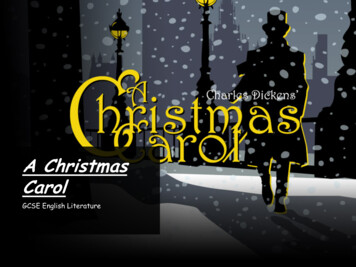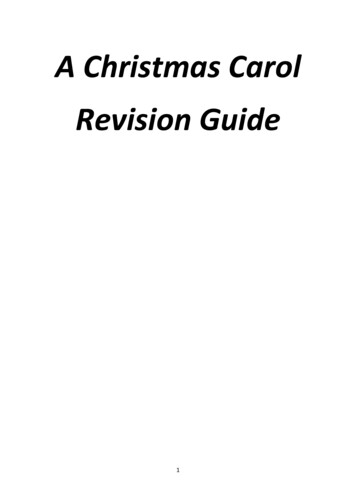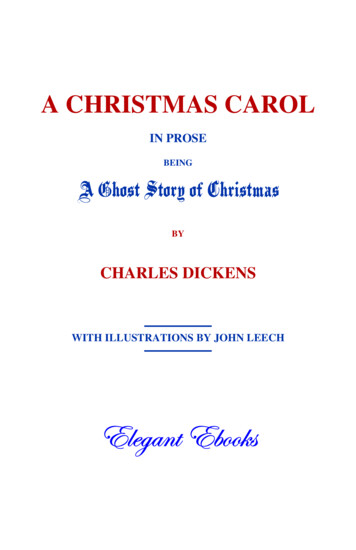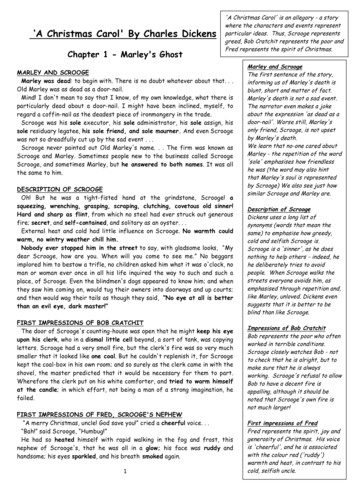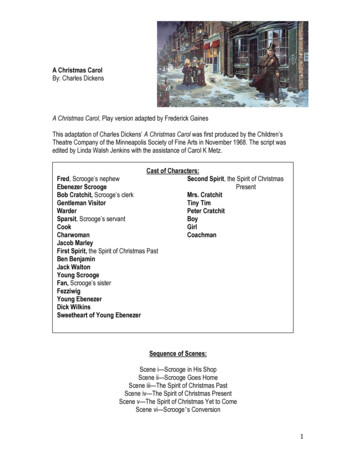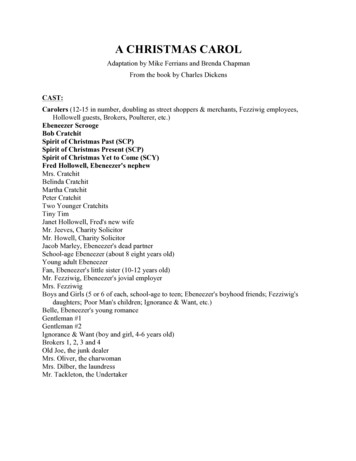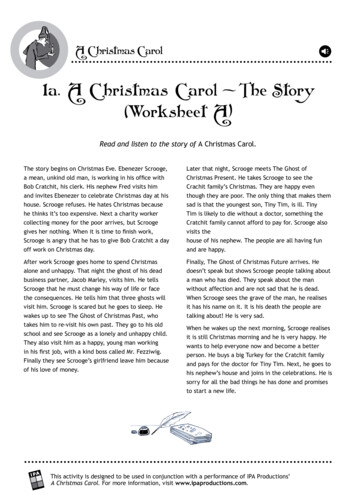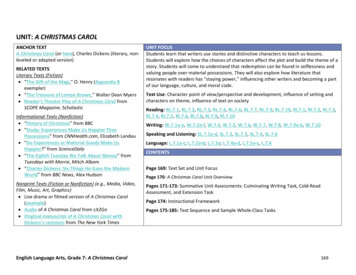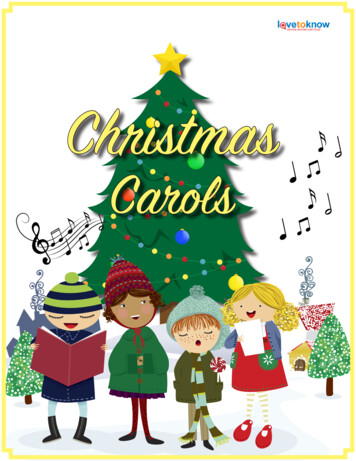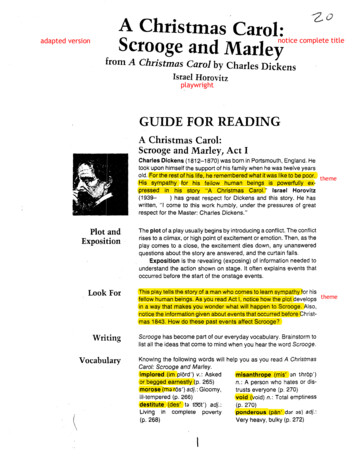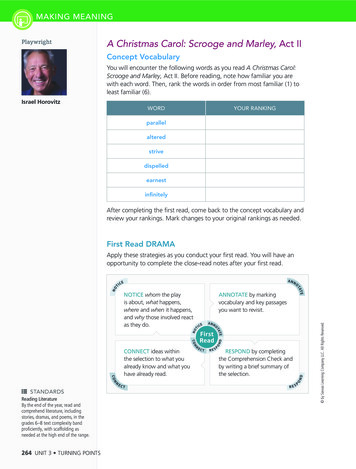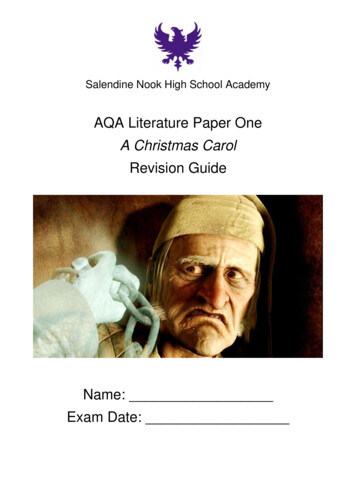
Transcription
Salendine Nook High School AcademyAQA Literature Paper OneA Christmas CarolRevision GuideName:Exam Date:
REMINDERIn the exam, you will be presented with a shortextract from the novella.There will only be ONE question on A ChristmasCarol – you MUST answer it!The question will ask you to focus on and idea orcharacter so you can show your understandingof the whole text.You can then demonstrate your word levellanguage analysis by finding further evidencefrom the extract.You are advised to spend 15 minutes planning,using your highlighter pen, margin notes andmind map, 30 minutes writing your response andthen 5 minutes carefully proof-reading it forSPAG accuracy! (You will have already spent theprevious 50 minutes in this exam writing yourresponse to the question on Shakespeare’sMacbeth.You have 1 hour 45 minutes for the whole paper.
HOW SHOULD I REVISE?1. Let’s start with reminding yourself about the novella, its author and thesocial and historical context – see pages 2 – 4. Once you’ve done this,put a tick next to this step.2. Done? Excellent. Now look at the sample exam question (unfortunately,we don’t have any old papers as this is a new specification) on page 5.Once completed put a tick next to this second step.3. Let’s now look at what the examiners are looking for and how youshould respond to a question. You’ll find all of this information on page6. Once completed, put a tick next to this third step.4. Right, here are the good quotes that we came up with in class as wellas what you could say about them for AO2 and AO3. See pages 7 – 10.Read through this table and put a tick next to this once completed.5. The blank table on page 11 should be used to plan for possiblequestions. I would suggest picking a theme from page 6 and then createa possible question, e.g. How does Dickens present the supernatural?Your eventual aim is to do this without referring to pages 7 – 10. Onceyou have done this for each of the possible themes, put a tick in thisbox.6. You’ll find that some quotes will be useful for pretty much any question– those are your gold quotes! Make revision flash cards for thesequotes to help you memorise them. It’s vital that you memorise as manyof these quotes as possible AND that you know what you’re going tosay about them (i.e. AO2 & AO3). This is one of the most importantrevision steps so spend time on it. Once completed put a tick next tothis step.7. And finally, practise, practise, practise (in timed conditions – 45 minutes– and with your quotes memorised). The more you do, the better (andquicker) you’ll get and the more prepared you’ll be. Put in the time andyou will have no regrets in August.
Dickens’ LifeCharles Dickens was born in 1812 in Kent and moved to London at the age of 9. When he was 12years of age, his father was arrested and sent to a debtors' prison. Dickens' mother moved sevenof their children into prison with their father but took Charles out of school and arranged for him tolive alone outside the prison, working with other child labourers in a terrible job which involvedpasting labels on bottles in a blacking (shoe polish) warehouse; he was poorly paid and theconditions were terrible.After his father was released from prison, Dickens returned to school, becoming a law clerk andthen a court reporter where he saw the harsh justice system first-hand. He used his ownexperiences of growing up in Kent and working as a court reporter in his stories. Dickens shockedaudiences of his day with his novels, where ‘gentlemen’ (the ones with the wealth and education)are the least morally ‘good’ characters and a convict turns out to be the most like a gentleman. Hecampaigned for a fairer justice system, a reform of the workhouses, the rights of the poor(particularly children) to have access to education, effective sewers and reasonable housing;many of his novels deal with these topics.With such colourful characters, riveting narratives and wonderfully descriptive language, Dickensbecame one of the most popular English novelists of his time, both in England and America. In1870, he eventually collapsed from overwork and died.Social and Historical ContextDickens was born into a time of great change in the way people lived. The industrial revolutionwas taking place and there was a sudden growth of the cities – the economy shifted fromagriculture to industry and trade. Money from industry made the rich, richer and the rich/poor gapwidened. Workers had to toil for long hours and little money. Out of necessity, children of all ages(even as young as five years old!) didn’t go to school and worked long hours for a wage in 1840s’Britain.The housing was appalling for working class families who lived in squalor, deprivation, diseaseand misery. They barely had enough money to buy food and the child mortality was very high. Inthe poorer quarters of Britain's larger cities almost 1 in 5 children born in the 1830s and 40s haddied by the age of five. The main causes of death were polluted drinking water, damp andtuberculosis, which claimed between 60,000 and 70,000 lives in each decade of Victoria's reign.There was no healthcare – if you got ill and couldn't work, your whole family was at risk of death.For those who were unable to support themselves, there were the workhouses: these were notintended as pleasant places to stay. Men, women and families were separated and those whowere physically able were expected to work for their keep. Similar to the workhouses were debtors'prisons (those who were unable to pay a debt), such as Marshalsea, where Charles Dickens'father spent time.The wealthy few on the other hand, lived in luxury with large houses, plenty of money, food andclothes. Their children didn’t work, were educated, had expensive toys and often went on holiday.Being seen to be civilised and adhering to a strict set of morals was important to high society inthe Victorian age. However, this was often criticised as being hypocritical for some of the reasonsmentioned above. Controversially there was a call for a Sunday Observance Bill (by the MP,Andrew Agnew) which would ban any business or recreations taking place on a Sunday. Thosewho supported it believed that it would ensure that Sunday remained a spiritual day. Those whoopposed it (Dickens was one of those – he wrote a scathing essay about Andrew Agnew) saw it asan attack on the poor who used Sundays to do what they liked. So, why do you think thatScrooge’s character attacks this idea when speaking to the Ghost of Christmas Present?
A Christmas CarolDuring this time of unrelenting social change, Dickens wrote A Christmas Carol. Firstly, he wantedto write a good 'ghost' tale – a few scares, a few laughs, a few tears – to cheer up families aroundthe hearth at winter (and to pay for his own turkey, no doubt); telling ghost-stories at Christmastime was a long-standing tradition (many Victorians believed in ghosts coming back tohaunt people) and the gothic genre was popular throughout the 19th century. However, healso had the intention of drawing readers' attention to the plight of England's poor, a recurringtheme in much of his work. As such, the novella can be read as a social criticism or anallegory (when a work has a social or political message). In the tale, Dickens includes adescription of the hardships faced by the poor alongside a heartless Malthusian* capitalist(Scrooge); the heart-rending, sentimental celebration of the Christmas season where Scroogeturns into generous private benefactor is what Dickens feels could be the answer to most ofsociety’s problems. Ironically, by concentrating on the 'pagan' traditions of Christmas, rather thanon the nativity, Dickens helped to change Christmas from a primarilyChristian festival to an inclusive, secular, social celebration – thenovella’s publication was the same year as the first commerciallyproduced Christmas card was sent!*Malthus’ Theory: see graph. The economist, Thomas Malthus sawhaving smaller families as one positive contribution to reducing theproblem of over-population. He also described any causes thatcontributed to “decreas[ing] the surplus population” (Scrooge’swords) as positive: war, famine and poor living & working conditionswhich might give rise to low resistance to disease.The Plot1. On Christmas Eve, Scrooge makes his clerk, Bob Cratchit, work in the cold.2. He refuses an invitation to his nephew Fred's Christmas party and will not give money to thecharity collectors.3. At home he is visited by the ghost of his old business partner, Jacob Marley, who warnsScrooge that his way of life will lead to misery.4. The Ghost of Christmas Past wakes Scrooge and shows him moments from his childhood, hisapprenticeship and his failed engagement.5. The Ghost of Christmas Present takes him to the Cratchit's home, where he is saddened bythe ill, but kind, Tiny Tim. He is also shown how Fred celebrates Christmas with friends andhow others celebrate Christmas together, despite being poor.6. The final ghost is the Ghost of Christmas Yet to Come who terrifies Scrooge with visions of hisdeath, where nobody mourns his passing. He also discovers that Tiny Tim has died.7. Scrooge awakes on Christmas Day and is delighted to find he has the chance to change hismiserly ways. He buys a turkey for the Cratchits and attends his nephew's party.8. Scrooge becomes like a second father to Tiny Tim (who doesn’t die) and gains a reputation forknowing how to celebrate Christmas.
So why does Scrooge change?1. He is upset at the thought that Tiny Tim might die.2. The Ghost of Christmas Present uses his own cruel words against him.3. He sees what he is missing in the family scenes of celebration.Writer’s Ideas/ThemesThe supernatural: this was a part of the Christmas story-telling tradition that started in the 17thcentury. By the 19th century, there was an interest in spiritualism; people believed spirits whoresided in the afterlife wanted to communicate with the living. Scrooge has 4 spirits who wish tocommunicate with him!Generosity and compassion: this is the essence of the Christmas spirit. It’s a time whenfamilies and friends come together in the home to share food and exchange gifts but it’s also atime when we’re supposed to think of those who are less fortunate than us. Scrooge’s nephewand his clerk show compassion towards Scrooge which is in stark contrast to those who coldlydismiss Scrooge (fellow business people, his servants, the pawn shop owner) as he does them. Isthere a message here, perhaps? A lack of compassion leads to a lack of compassion?Redemption: This means seeing the error of your ways and being saved from sin or evil. Scroogeis transformed from a mean, greedy and lonely old miser, who was blind to his sin, into agenerous, goodnatured, beloved character and just in time! The moral message of the novella isthat all human beings have the opportunity / can make the choice to behave in kinder waystowards each other and be saved from damnation (don’t forget the religious aspect!).Social injustice: Just like An Inspector Calls, Dickens’ story is an attack on a society where thereis an unequal distribution of wealth: the rich, who enjoy comfort and feasting at Christmas, ignorethe dreadful living conditions of the poor; in fact, they effectively punish the poor for their povertythrough such things as the “Treadmill” and the “Workhouses”. The thieves show how people weredriven to steal from the dead. The Ghost of Christmas Present presents the children (Ignoranceand Want) and states that “They are Man’s” responsibility.Structure of the novellaCarol singing was popular when Dickens wrote A Christmas Carol and he was certainly a lover ofmusic. A carol is a festive song, particularly popular at Christmas (these carols are often aboutChrist’s birth and the spirit of giving). When songs are written they’re done so on staves. A stave isa set of five parallel lines on which a musical note is written (see below). So, referring to thechapters as staves links to the title of the novella and perhaps suggests to the reader that thiswill ultimately be a joyous/moral tale. The final (fifth) stave returns to many of the ideas in Stave 1so there’s symmetry to the novella. Furthermore, the last stave is both short and upbeat withScrooge having rejected all of his earlier miserly ways, becoming a good Christian again.
SAMPLE EXAM QUESTIONYou will get an extract from the novella and one question, which will be in two parts. See below forthe sample question that the exam board have provided. Charles Dickens: A Christmas CarolRead the following extract from Chapter 1 and then answer the question that follows. In thisextract, Scrooge is being introduced to the reader.Oh! But he was a tight-fisted hand at the grindstone, Scrooge! a squeezing,wrenching, grasping, scraping, clutching, covetous old sinner! Hard and sharpas flint, from which no steel had ever struck out generous fire; secret, and selfcontained, and solitary as an oyster. The cold within him froze his old features,nipped his pointed nose, shrivelled his cheek, stiffened his gait; made his eyesred, his thin lips blue; and spoke out shrewdly in his grating voice. A frostyrime was on his head, and on his eyebrows, and his wiry chin. He carried hisown low temperature always about with him; he iced his office in the dog-days;and didn't thaw it one degree at Christmas. External heat and cold had littleinfluence on Scrooge. No warmth could warm, no wintry weather chill him. Nowind that blew was bitterer than he, no falling snow was more intent upon itspurpose, no pelting rain less open to entreaty. Foul weather didn't know whereto have him. The heaviest rain, and snow, and hail, and sleet, could boast ofthe advantage over him in only one respect. They often came downhandsomely, and Scrooge never did. Nobody ever stopped him in the street tosay, with gladsome looks, My dear Scrooge, how are you. When will youcome to see me.'' No beggars implored him to bestow a trifle, no childrenasked him what it was o'clock, no man or woman ever once in all his lifeinquired the way to such and such a place, of Scrooge. Even the blindmen'sdogs appeared to know him; and when they saw him coming on, would tugtheir owners into doorways and up courts; and then would wag their tails asthough they said, No eye at all is better than an evil eye, dark master! '' Butwhat did Scrooge care! It was the very thing he liked. To edge his way alongthe crowded paths of life, warning all human sympathy to keep its distance,was what the knowing ones call nuts to Scrooge.Starting with this extract, how does Dickens present Scrooge as an outsider to society?Write about: how Dickens presents Scrooge in this extracthow Dickens presents Scrooge as an outsider to society in the novel as a whole.[30 marks]
What Are The Examiners Looking For?(30 marks: AO1 12, AO2 12, AO3 6)AO1AO2AO3Read, understand and respond to texts.Students should be able to: maintain a critical style and develop an informed personal response use textual references, including quotations, to support and illustrateinterpretations.Analyse the language, form and structure used by a writer to create meanings andeffects, using relevant subject terminology where appropriate.Show understanding of the relationships between texts and the contexts in which theywere written.What Should I Write?1. Firstly, highlight the key words in the question2. Now read the extract and highlight good evidence to answer the first bullet point of yourquestion, using your left hand margin to note inferences (understand, think, feel) and righthand margin to note methods/deliberate choices made by the writer. Then mind map 3 ideasthat respond to the question from the extract and 2 from the rest of the text. (10 mins)3. Write essay. Don’t bother with an introduction – go straight into analysing the extract using upto 3 IMERCI paragraphs (20 mins)4. Write a couple of detailed IMERCIs for the second part of your question. (15 mins)5. Sum up how the writer presents whatever the question asks. (5 mins)Model Paragraph For A Question About How Scrooge is Presented:AO1 (how well you answer the question & use quotes): 40%AO2 (Analysis of language, structure and form): 40%AO3 (Context and Writer’s Ideas): 20%The language in this extract makes it clear how mean-spirited and miserly Scrooge is. Firstly, he isdescribed as being “as solitary as an oyster”, a simile which demonstrates how Scroogelocks himself away from society and has a hard demeanour (although the simile alsoforeshadows Scrooge later revealing his softer side). The listing of similes also suggests theidea of him being a difficult and complicated character. Furthermore, the use of sibilancesuggests that he is frightening; this is reinforced by sinister physical descriptions where he isdescribed as having “eyes red” and “lips blue”, evoking images of the living dead. Such gothicdescriptions would have appealed to a Victorian readership, who were fascinated with themacabre and would have identified Scrooge as being a wicked character; Dickens may havewished to suggest to his primarily middle class readership, who were highly concernedwith appearance, that those who behave wickedly will appear wicked. Dickens thenjuxtaposes Scrooge’s character alongside Fred’s in order to
AO1 (how well youanswer the question &use quotes): 40%“squeezing, wrenching,grasping, scraping ” link to“one coal”“as solitary as an oyster”“eyes red lips blue” link tothe ghost “coming up thestairs” link to “The chain. . .was long, and wound abouthim like a tail” and “infernalatmosphere”“fog”“a stake of holly through hisheart” vs. Fred’s(“handsome eyessparkled”) / “think of peoplebelow them”AO2 (Analysis of language, structure and form): 40%AO3 (Context and Writer’s Ideas): 20%3rd person narration delivers a judgemental and somewhat mockingtone which portrays Scrooge in a negative light. Asyndetic listing ofverb modifiers which are all synonyms with negative connotationssuggest that there’s no end to his selfish actions – this is reinforcedby the “one coal” that he allows his clerk in the middle of winter; thereader would feel sympathy for Bob Cratchit (the clerk).Simile – hard on the outside but hints (foreshadows his latertransformation) at a softer inner self. Sibilance creates a sinistereffect which links to his description (see next piece of evidence).Placement of adjectives is reverse of expectations – suggests he’s amonster. Gothic atmosphere is continued with Dickens’ use ofellipsis of “it was” and the use of the present participle “coming” tocreate the effect of it happening now – tense for the reader. SeeGeorge Booth’s paragraph on the blog to see how you could writeabout this more complex analysis. The description of Marley’s ghostis disturbing and the “tail” is suggestive of a snake, which itself issymbolic of the devil – this idea is reinforced by “infernal (relating tohell) atmosphere”.Repetition / pathetic fallacy create an uninviting atmosphere (whichlinks to Scrooge’s personality at the start). Also symbolic ofScrooge’s inability to see the good around him.This reflects the wealthy who made money at theexpense of the poor workers. Dickens was renownedfor his detailed writing style with lots of long lists,powerful adjectives, similes and metaphors. After all,he had to fill a weekly column each week!Using items associated with Christmas to kill those who celebrateChristmas is violent imagery but so exaggerated that Scrooge’scharacter seems more ridiculous than sinister: Dickens doesn’t wantthe reader to really hate Scrooge’s character otherwise we wouldfeel no joy at his later “transformation”. The juxtaposition of Fred’scharacter who is handsome and charitable makes Scrooge’scharacter seem even uglier.Gothic description – popular genre. There’s also asimilarity to the way that Frankenstein’s monster isdescribed in Mary Shelley’s earlier novel (written in1818). The image of purgatory would have been veryrecognisable (and frightening!) to a Christianreadership.London was known for its smog (mixture of smokeand fog) from all the factories and homes. Dickensactually opens his novel Bleak House by describingthe smog as being responsible for the “death of thesun”.Readers would have instantly associated the “holly”and “pudding” with Christmas.
AO1 (how well you answerthe question & usequotes): 40%“A solitary child” link to“father much kinder than heused to be”Fezziwig: “fuel heaped uponthe fire” / “happiness hegives.as great.as a fortune”link to “clerk”“I release you” from the“contract” link to “a golden[idol]”“alone”“he could not hide the light”“Transformation” link to “Light”link to “Let me profit by it”“Because [poverty] needs itmost.”link to “This earth of yours”link to “They are man’s” –“Ignorance” & “Want” –“shrivelled” & “twisted”AO2 (Analysis of language, structure and form): 40%The use of the Ghost of Christmas Past allows the reader to feel sympathy forScrooge as we realise that he may have been treated unkindly as a child.Scrooge feels sympathy first for himself and then the young carol singer hethreatened the previous evening and then he feels guilty about not being abetter uncle to the nephew of his sister who had “a large heart” and diedyoung.All of the words associated with Fezziwig have positive connotations.Scrooge actually argues with the ghost who tricks him into defending hisformer boss by saying that Fezziwig didn’t spend much on the party. It alsomakes Scrooge think about how he treats his “clerk”.This is the language of commerce, which demonstrates that Belle (a namethat means beautiful incidentally) understands that Scrooge is obsessed withmoney. It also suggests that he is no longer a good Christian – see context Repeated – suggesting that selfishness will lead to a life of loneliness but alsointimates that individually we must pay for our sins in life, e.g. like JacobMarley does.Light is repeated and is symbolic of see the truth/right path to take. Scroogedoesn’t want to know what his greed has done to him (and others), i.e. losingBelle. He’d rather remain in his “fog” than be illuminated (learn from his past tochange his presentactions – similar idea to An Inspector Calls).Scrooge’s room had been transformed and the word “light” is repeated againbut Scrooge has also been transformed: he wishes to “profit” by learning any“lesson” the Ghost of Christmas Present has to teach. However, the languageof commerce heresuggests that his learning isn’t yet complete.Personification of poverty to elicit sympathy – reinforced by the shortsentence. When Scrooge questions the laws done in God’s name, there’s anattack by the ghost saying the laws are man’s creation. Later he presents thetwo children (more personification)to metaphorically represent the rich (ignorant) and the poor (those who areneed help); Ignorance might also be interpreted as the lack of educationafforded to the poor, which would have enabled them to forge better lives. Thedescription of the poor children is particularly shocking/horrifying.AO3 (Context and Writer’s Ideas): 20%Dickens himself felt lonely when his family went to adebtors’ prison.A biblical allusion (it is a Christmas story afterall!) to the story of the gold calf which wasworshipped as a false god.The second idea here would have been arecognisable passage from the bible(Corinthians) to Victorian readers who wouldhave been well versed in the scriptures.There is another biblical allusion here. Lightrepresents goodness/hope/God. Again, thiswould have been obvious to a Victorian readership.Dickens was familiar with the poor workingconditions of the workers. He also campaignedfor the education rights for children. As well asthis, see the note about the proposed SundayObservance Bill in the contextual information,which relates to this exchange between theghost & Scrooge. You may need to reread theextract.
AO1 (how well you answer thequestion & use quotes): 40%“Decrease the surplus population” linkto “Scrooge hung his head” link todiscovered What thesurplus is”“Their clothes were scanty but theywere happy” link to “remember uponChristmas Day, who made lamebeggars walk”“If these shadows remain unaltered bythe Future, the child will die.”“His wealth is of no use to him. He don’tdo any good with it.”“I hope to live to be another man” or“he resolved to treasure up every word”or “I will honour Christmas in all myheart”“calico becoming to the body” link to“they have brought him to a rich end”AO2 (Analysis of language, structure and form): 40%AO3 (Context and Writer’s Ideas): 20%The ghost uses Scrooge’s earlier words to attack him when Scroogebegs for Tiny Tim’s life to be spared. There’s also another nice quote(metaphor) about the “insect on the leaf” that you may wish to use (seeStave 3).This is also Dickens’ attack on Malthus’Theory.Don’t forget that Scrooge is a metaphor forMalthusian capitalists. See contextualinformation above if you can’t recall what thetheory involves.Dickens challenges preconceptions that thewealthy had about the poor. The story ofJesusperforming miracles upon the lame and theblind would have been well-known.The Cratchits make do with the very little they have, are caring andsupportive of one another – shows their generous spirit, even inchallenging circumstances (we also see this when the ghost takesScrooge to a number of terrible places). Even Tiny Tim’s comment isgenerous: he sees his disability positively as it will make others think ofJesus on Christmas Day. Scrooge is very moved by Tiny Tim and showsconcern.The conditional subordinate clause represents Scrooge’s futureactions & it’s also repeated later. In terms of syntax, the main clausehas been placed at the end to demonstrate the results of those actions.The brevity of the main clause is shocking and emotive and representsTiny Tim’s short life. Furthermore, the modal verb “will” conveyscertainty, making it all the more emotive & persuades Scrooge that histransformation is urgently required in order to save the boy.Unlike his guests, Fred feels sympathy not anger towards Scrooge. He’sa forgiving character even though he’s been treated badly by Scrooge.The contrast between Fred and Scrooge is evident throughout the noveland emphasises Scrooge’s misery, selfishness and urgent need forredemption.Use any of these quotes to contrast with Scrooge’s stubbornness andfeelings about others/Christmas at the start of the novella.Scrooge’s good shirt has been replaced by one made of “calico”, whichthe servant feels is fitting to the type of person he was; his moreexpensive items are sold to make them money. Scrooge’s body is dealtwith by cruel, ugly people who treat his memory the way he treatedothers in life. Scrooge is horrified and seems to understand that moneyis not as important as friends and family.Child mortality was high and this was largelydueto the terrible living conditions of the poorwhostruggled to survive on such low wages. Seecontextual information above.Links to Dickens’ desire for a fairer, morecaringsociety. See contextual notes.Calico is a very cheap material. Thedeceasedwere usually dressed in their best attire; fortherich that would be silk shirts, etc.
AO1 (how well you answer thequestion & use quotes): 40%“bereft, unwatched, unwept,uncared for was the body” link to“his sole friend, and sole mourner”link to “a happier house for thisman’s death” link to “[Fred] is thepleasantest-spoken gentleman”“My little child! My little child!” linkto “thy childish essence was fromGod!”“I am as light as a feather as happyas an angel ”“clang, clash, hammer” link to“glorious glorious!”“cold” link to “everything couldyield him pleasure”“no fog, no mist, clear, bright”“some people laughed these wouldbe blind anyway” link to “standingin the spirit at your elbow”“to Tiny Tim, who did not die, hewas a second father”AO2 (Analysis of language, structure and form): 40%AO3 (Context and Writer’s Ideas): 20%Another long list of adjectives, which are synonyms. Compare withrepetition of “sole” (6 times in one sentence!) about Marley at thestart of the novella – emphasises that nobody cares about him andreminds us how similar Marley and Scrooge are. Then contrastwhat was said about Scrooge with what was said about Fred.This went against what Victoriansconsidered to be a “good death” whereyou die surrounded by friends & family andthen are mourned afterwards.The repeated short exclamations are honest & emotive. BobCratchit would elicit sympathy (perhaps guilt?) from primarily female,wealthy readers. Tiny Tim’s generous spirit & selflessness representthe Christmas spirit and as such he seems like an unnecessarysacrifice due to the selfishness of the wealthy.Lots of similes to show both Scrooge’s elation at a ‘second chance’in life (he’s been ‘saved’) and to demonstrate how difficult it is to putinto words how happy he is. The “angel” certainly contrasts with thedevilish description of Marley at the start of the novella.Onomatopoeia of unpleasant sounds and yet Scrooge appreciatesthem which is evident when he repeats/exclaims, “glorious”.Link to the high mortality rate of children,particularly amongst the poor – seecontextualnotes.Something normally unpleasant like the “cold” gives Scrooge“pleasure” – demonstrates how he has changed / appreciateseverything around him.Motifs of dark and light again. The “fog” that was repeated at thestart is now gone. He has learnt his lesson and transformed.The narrator seems to remind us that there are still those who arelike Scrooge in society. The declarative sentence suggests certaintyfrom a mysterious narrator who is “at your elbow” (suggesting that thenarrator is an angel/God?) to persuade the selfish wealthy to changetheir ways for the Day of Judgement.Scrooge has an adopted family. The relative clause and theitalicising (capitalisation in some editions) of “not” demonstrates thatScrooge’s choices/actions ultimately saved Tim’s life. The novellaends on positive note sugge
A Christmas Carol During this time of unrelenting social change, Dickens wrote A Christmas Carol. Firstly, he wanted to write a good 'ghost' tale – a few scares, a few laughs, a few tears – to cheer up families around the hearth at winter (and to pay for his own turkey, no dou
